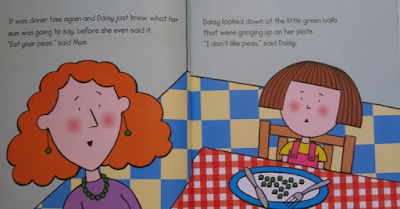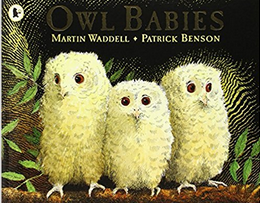PICTURE BOOK KNOWHOW Wonderfully Useful Refrains: Why Patterns Matter
This month, picture book experts, Natascha Biebow and Ellie Farmer, look at picture book refrains and how including one can help to boost your picture book writing.
 |
| From Wow! Said the Owl by Tim Hopgood |
Young children have an innate sense of order and this is essential in how they develop and learn about the world. Rhythm, pattern and routine are comforting and soothing and have been shown to help foster language development.
 |
| Child ordering Montessori colour tablets |
Refrains allow the story to build up to a climactic turning point where the refrain is either repeated for emphasis or there is a shift in the narrative and the refrain is turned on its head.
For example, in EAT YOUR PEAS, by Kes Gray and Nick Sharratt, Daisy does not
like peas . . .
 |
| From Eat Your Peas by Gray & Sharratt |
So, no matter what Mum promises . . .
 |
| From Eat Your Peas by Gray & Sharratt |
 |
| From Eat Your Peas by Gray & Sharratt |
"I don't like peas!" said Daisy.helps to escalate the conflict between Mum and Daisy until it reaches a turning point. It also adds humour to the book.
Having a pattern in the words allows readers to focus on the elements that do change, giving them more emphasis in the advancement of the characters and the plot. For instance, in CLICK, CLACK, MOO, COWS THAT TYPE by Doreen Cronin and Betsy Lewin, the cows have got hold of a typewriter:
 |
| From Click, Clack, Moo Cows that Type by Cronin & Lewin |
"Click, clack, moo. Click, clack, moo.
Clickety, clack, moo.”
When the farmer doesn't budge, the cows issue him with an ultimatum – they want electric blankets otherwise there will be no eggs and no milk! Duck helps mediate. When, eventually a solution is found - the cows will exchange their typewriter for the electric blankets – the book ends with a shift to the refrain:
 |
| From Click, Clack, Moo Cows that Type by Cronin & Lewin |
Often, having the constant of a refrain means readers don’t have to ‘think’ quite so hard about what is coming, because it’s a given. In THE GRUFFALO by Julia Donaldson and Axel Sheffler, the pattern of the refrain
“A gruffalo? What’s a gruffalo?”
“A gruffalo! Why, didn’t you know?”
 |
| From The Gruffalo by Donaldson & Sheffler |
means that every time it appears, the suspense and mystery surrounding the gruffalo builds, but also that there is an additional emphasis on the beast's features revealed by each subsequent page turn:
 |
| From The Gruffalo by Donaldson & Sheffler |
Refrains are often lots of fun to read aloud, too. This makes them memorable and, in turn, the book becomes one that children request over and over again. Here are some examples of fun refrains that you can take a closer look at. Notice how the author uses the patterning in the refrain to escalate the tension in the narrative and the reader's expectation of the outcome:
“I really want to eat a child!”
“Application DENIED!”
“This is a job for . . . FIX-IT DUCK.”
 |
| "I want my mummy!" said Bill. |
Natascha Biebow is
an experienced editor, mentor and coach, who loves working with authors
and illustrators at all levels to help them to shape their stories. www.blueelephantstoryshaping.com
Check out the Cook Up a Picture Book Coaching Courses.


















No comments:
We love comments and really appreciate the time it takes to leave one.
Interesting and pithy reactions to a post are brilliant but we also LOVE it when people just say they've read and enjoyed.
We've made it easy to comment by losing the 'are you human?' test, which means we get a lot of spam. Fortunately, Blogger recognises these, so most, if not all, anonymous comments are deleted without reading.